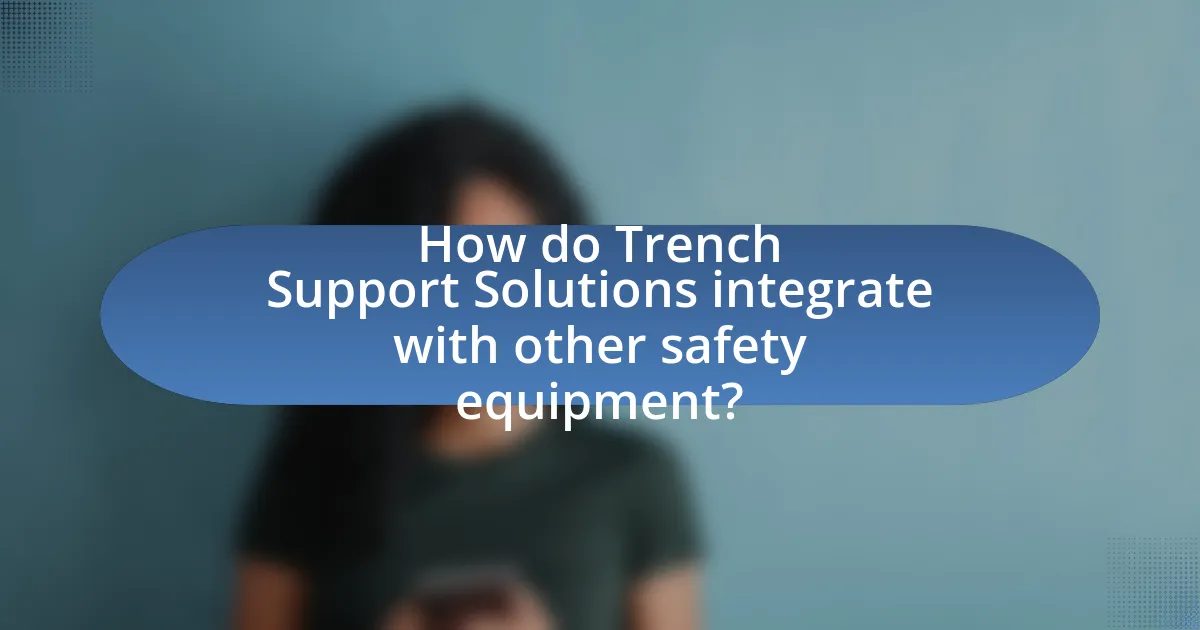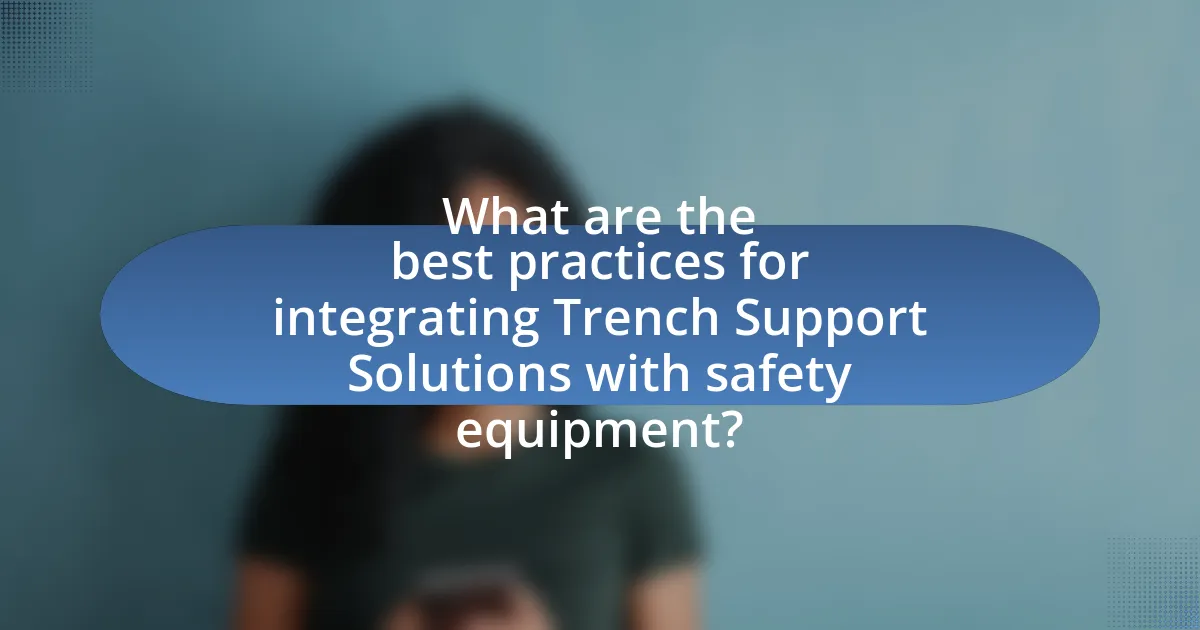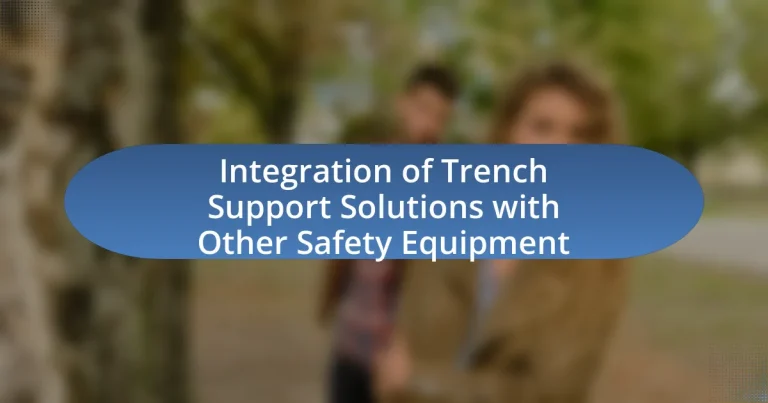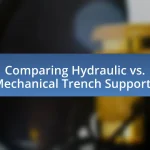Trench Support Solutions are essential systems designed to prevent soil collapse and ensure worker safety in excavated areas during construction activities. This article explores the various types of trench support solutions, such as trench boxes and hydraulic shoring, and their critical role in mitigating risks associated with trench collapses, which account for a significant number of construction-related fatalities. It also discusses the integration of these solutions with other safety equipment, including personal protective gear and warning systems, to enhance overall safety on job sites. Best practices for effective integration, including training, inspections, and compliance with safety regulations, are highlighted to ensure a cohesive safety framework that protects workers and minimizes accidents.

What are Trench Support Solutions?
Trench Support Solutions are systems designed to prevent soil collapse and ensure the safety of workers in excavated areas. These solutions typically include trench boxes, shoring systems, and other support structures that stabilize the walls of trenches during construction or maintenance activities. The use of trench support solutions is critical, as the Occupational Safety and Health Administration (OSHA) reports that trench collapses can occur within seconds, posing significant risks to workers. Proper implementation of these solutions not only enhances safety but also complies with regulatory standards, thereby reducing the likelihood of accidents and injuries on job sites.
How do Trench Support Solutions function in construction?
Trench Support Solutions function in construction by providing structural support to excavations, preventing soil collapse and ensuring worker safety. These solutions typically include systems such as trench boxes, shoring, and bracing, which are designed to stabilize the walls of trenches during excavation activities. For instance, trench boxes are prefabricated units that can be placed in the trench to protect workers from cave-ins, while shoring systems use hydraulic or mechanical means to support the trench walls. The effectiveness of these solutions is backed by OSHA regulations, which mandate protective measures for trenches deeper than five feet, highlighting the critical role of trench support in maintaining safety standards on construction sites.
What types of Trench Support Solutions are commonly used?
Commonly used trench support solutions include trench boxes, hydraulic shoring, and soil nails. Trench boxes, also known as trench shields, are prefabricated structures that protect workers from cave-ins by providing a safe working environment within the trench. Hydraulic shoring utilizes hydraulic systems to support trench walls, allowing for adjustable and effective stabilization. Soil nails are long, slender elements that are inserted into the soil to reinforce the trench walls, providing additional support. These solutions are essential for ensuring worker safety and compliance with regulations, such as those outlined by the Occupational Safety and Health Administration (OSHA), which mandates protective measures for trenches deeper than five feet.
What materials are typically used in Trench Support Solutions?
Trench support solutions typically utilize materials such as steel, aluminum, and composite materials. Steel is favored for its strength and durability, making it ideal for heavy-duty applications. Aluminum is lightweight and corrosion-resistant, suitable for environments where weight is a concern. Composite materials offer a balance of strength and reduced weight, often used in specialized applications. These materials are selected based on their ability to withstand soil pressures and provide safety during excavation work, ensuring structural integrity and worker protection.
Why are Trench Support Solutions critical for safety?
Trench Support Solutions are critical for safety because they prevent collapses in excavated areas, which can lead to serious injuries or fatalities. According to the Occupational Safety and Health Administration (OSHA), trench collapses account for approximately 25% of all excavation-related fatalities. These solutions, such as trench boxes and shoring systems, provide structural integrity and support to the walls of trenches, thereby safeguarding workers from potential hazards. The implementation of these systems is essential in compliance with safety regulations, ensuring that excavation sites are secure and reducing the risk of accidents.
What risks do Trench Support Solutions mitigate?
Trench Support Solutions mitigate risks associated with trench collapses, worker injuries, and fatalities during excavation activities. These solutions provide structural support to prevent soil movement, thereby reducing the likelihood of cave-ins, which are a leading cause of construction-related deaths. According to the Occupational Safety and Health Administration (OSHA), approximately 1 in 5 worker fatalities in the construction industry are due to falls, being struck by objects, electrocutions, and trench collapses. By implementing trench support systems, such as shoring and shielding, companies can significantly enhance safety and compliance with regulatory standards, ultimately protecting workers and minimizing liability.
How do Trench Support Solutions comply with safety regulations?
Trench Support Solutions comply with safety regulations by adhering to established standards such as OSHA (Occupational Safety and Health Administration) guidelines and local safety codes. These solutions are designed to prevent cave-ins and protect workers by utilizing engineered systems that meet specific load requirements and safety factors. For instance, trench boxes and shoring systems are tested and certified to ensure they can withstand the forces exerted by surrounding soil, thereby minimizing risks during excavation activities. Compliance is further ensured through regular inspections and maintenance of the equipment, as well as training for personnel on proper usage and safety protocols.

How do Trench Support Solutions integrate with other safety equipment?
Trench Support Solutions integrate with other safety equipment through a coordinated system that enhances worker protection in excavation sites. These solutions, such as trench boxes and shoring systems, are designed to work in conjunction with personal protective equipment (PPE) like hard hats, safety vests, and harnesses, ensuring comprehensive safety measures. For instance, when trench boxes are used, they provide a stable environment that complements the use of PPE by reducing the risk of cave-ins, which is a leading cause of fatalities in excavation work. Additionally, safety monitoring devices, such as gas detectors and alarms, can be integrated with trench support systems to provide real-time alerts about hazardous conditions, further enhancing safety protocols. This integration is crucial, as statistics indicate that proper use of trench support systems can reduce the likelihood of accidents by up to 90%, demonstrating their effectiveness when combined with other safety measures.
What types of safety equipment are commonly integrated with Trench Support Solutions?
Common types of safety equipment integrated with Trench Support Solutions include trench boxes, shoring systems, and safety barriers. Trench boxes provide a protective enclosure for workers in excavations, while shoring systems support the walls of trenches to prevent collapses. Safety barriers are used to delineate work zones and protect workers from traffic or other hazards. These integrations enhance worker safety by minimizing the risk of trench-related accidents, which are a significant concern in construction, as evidenced by OSHA statistics indicating that trench collapses account for a substantial number of fatalities in the industry.
How do personal protective equipment (PPE) complement Trench Support Solutions?
Personal protective equipment (PPE) complements trench support solutions by providing essential safety measures that protect workers from hazards associated with trenching operations. PPE, such as helmets, gloves, and high-visibility clothing, enhances the effectiveness of trench support systems by ensuring that workers are safeguarded against potential risks like falling debris, slips, and exposure to hazardous materials. For instance, the use of hard hats can prevent head injuries in the event of a collapse, while high-visibility gear ensures that workers are easily seen in low-light conditions, reducing the risk of accidents. This integration of PPE with trench support solutions creates a comprehensive safety framework that significantly lowers the likelihood of injuries on construction sites.
What role do warning systems play in the integration process?
Warning systems are crucial in the integration process of trench support solutions with other safety equipment as they provide real-time alerts about potential hazards. These systems enhance situational awareness by notifying workers of unsafe conditions, such as soil instability or equipment malfunctions, thereby preventing accidents. For instance, studies have shown that the implementation of advanced warning systems can reduce incident rates by up to 30% in construction environments. This demonstrates that effective warning systems not only facilitate safer operations but also contribute to the overall efficiency of integrated safety measures.
How does the integration enhance overall safety on-site?
The integration of trench support solutions with other safety equipment enhances overall safety on-site by creating a comprehensive safety system that minimizes risks associated with excavation work. This integration allows for real-time monitoring of trench conditions, ensuring that any potential hazards, such as soil instability or equipment malfunctions, are promptly identified and addressed. For instance, studies have shown that using combined safety measures, such as trench boxes alongside monitoring sensors, can reduce the incidence of accidents by up to 50%. This collaborative approach not only protects workers but also ensures compliance with safety regulations, thereby fostering a safer work environment.
What are the benefits of a cohesive safety system?
A cohesive safety system enhances workplace safety by ensuring that all safety measures work together effectively. This integration minimizes risks, as it allows for real-time communication between different safety equipment, such as trench support solutions and personal protective gear. For instance, studies show that organizations implementing cohesive safety systems experience up to a 40% reduction in workplace accidents, as the interconnectedness of safety protocols leads to quicker response times and better hazard identification. Additionally, cohesive systems streamline training processes, making it easier for employees to understand and adhere to safety practices, further reinforcing a culture of safety within the organization.
How does integration improve emergency response capabilities?
Integration improves emergency response capabilities by enhancing communication and coordination among various emergency services. When trench support solutions are integrated with other safety equipment, responders can share real-time data, streamline operations, and reduce response times. For instance, a study by the National Institute of Standards and Technology found that integrated systems can improve situational awareness, leading to a 30% increase in operational efficiency during emergencies. This integration allows for better resource allocation and more effective management of complex incidents, ultimately saving lives and minimizing damage.

What are the best practices for integrating Trench Support Solutions with safety equipment?
The best practices for integrating Trench Support Solutions with safety equipment include ensuring compatibility, conducting thorough training, and implementing regular inspections. Compatibility between trench support systems and safety equipment, such as personal protective gear and monitoring devices, is crucial to prevent accidents. Training workers on the proper use of both trench support solutions and safety equipment enhances awareness and reduces risks. Regular inspections of both systems ensure they function correctly and meet safety standards, thereby minimizing potential hazards. These practices are supported by industry guidelines, such as those from the Occupational Safety and Health Administration (OSHA), which emphasize the importance of proper equipment integration for worker safety.
How can construction teams ensure effective integration?
Construction teams can ensure effective integration by implementing a collaborative approach that includes regular communication, standardized protocols, and the use of compatible technologies. Regular communication among team members fosters a shared understanding of project goals and safety requirements, which is essential for integrating trench support solutions with other safety equipment. Standardized protocols, such as those outlined by the Occupational Safety and Health Administration (OSHA), provide clear guidelines for equipment use and safety measures, ensuring that all team members are aligned in their practices. Additionally, utilizing compatible technologies, such as integrated software systems for project management and safety monitoring, enhances coordination and minimizes the risk of equipment incompatibility. This approach is supported by studies indicating that projects with strong communication and standardized practices experience fewer safety incidents and improved efficiency.
What training is necessary for personnel regarding integrated safety systems?
Personnel must undergo comprehensive training on integrated safety systems that includes understanding system components, operational protocols, and emergency response procedures. This training ensures that personnel can effectively utilize trench support solutions in conjunction with other safety equipment, minimizing risks during operations. Specific training modules should cover the functionality of integrated systems, hazard recognition, and the proper use of personal protective equipment. Additionally, hands-on simulations and assessments are essential to reinforce knowledge and skills, ensuring personnel are prepared for real-world scenarios.
How can regular inspections improve integration effectiveness?
Regular inspections enhance integration effectiveness by identifying potential issues early, ensuring that trench support solutions and safety equipment function cohesively. These inspections allow for the assessment of compatibility between different safety systems, which is crucial in preventing accidents. For instance, a study by the Occupational Safety and Health Administration (OSHA) indicates that regular equipment checks can reduce workplace incidents by up to 30%. This proactive approach not only maintains operational efficiency but also fosters a culture of safety, ultimately leading to improved integration of safety measures in trench operations.
What common challenges arise during integration, and how can they be addressed?
Common challenges during the integration of trench support solutions with other safety equipment include compatibility issues, communication breakdowns, and regulatory compliance. Compatibility issues arise when different systems or equipment do not work well together, which can be addressed by conducting thorough compatibility assessments and selecting equipment designed for interoperability. Communication breakdowns often occur between teams or systems, leading to misunderstandings; this can be mitigated by establishing clear communication protocols and regular coordination meetings. Regulatory compliance challenges can arise due to varying safety standards; addressing this requires staying updated on regulations and ensuring all equipment meets the necessary safety criteria.
What are the typical pitfalls in integrating safety equipment?
The typical pitfalls in integrating safety equipment include inadequate compatibility assessments, insufficient training for personnel, and neglecting regulatory compliance. Inadequate compatibility assessments can lead to equipment that does not function effectively together, resulting in safety hazards. Insufficient training for personnel can cause improper use of safety equipment, increasing the risk of accidents. Neglecting regulatory compliance can result in legal penalties and unsafe working conditions, as safety standards are not met. These pitfalls highlight the importance of thorough planning and evaluation in the integration process.
How can teams troubleshoot integration issues effectively?
Teams can troubleshoot integration issues effectively by following a systematic approach that includes identifying the root cause, validating configurations, and conducting thorough testing. First, teams should gather detailed logs and error messages to pinpoint where the integration fails. Next, they must ensure that all configurations align with the specifications of both the trench support solutions and the safety equipment, as misconfigurations are a common source of issues. Finally, conducting integration tests in a controlled environment allows teams to replicate the problem and verify that solutions work before deployment. This methodical process is supported by industry best practices, which emphasize the importance of documentation and communication among team members to facilitate quick resolution of integration challenges.
What are the key takeaways for successful integration of Trench Support Solutions with safety equipment?
Successful integration of Trench Support Solutions with safety equipment requires a comprehensive approach that prioritizes compatibility, training, and compliance with safety standards. Ensuring that trench support systems are designed to work seamlessly with safety gear, such as helmets and harnesses, enhances worker protection. Training personnel on the proper use of both trench support and safety equipment is crucial, as it minimizes risks associated with improper usage. Additionally, adherence to safety regulations, such as those outlined by OSHA, reinforces the effectiveness of the integration, as compliance ensures that all equipment meets established safety criteria.


